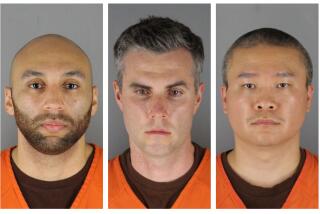When the Best Medicine Is Not Trying Too Hard
- Share via
NEW YORK — A severe gastrointestinal bleed. That’s what he came in with. It was 11 in the evening, and everyone knew it was going to be a long night.
His first trip was to the emergency room to see if doctors could stop the bleeding without surgery. They failed. So it was off to the operating room. Back on the floor that morning, things didn’t go well, either. A high fever. Then more stomach pain. The surgeons had to operate again the next day.
Finally, Michael was stable. His doctors broke the bad news. He knew the litany, by now, as well as his oncologists. Elevated bilirubin, liver cirrhosis, a stent, inserted to alleviate some of the pain, that keeps clogging up. Another trip to the operating room to fix it. He had been in and out of the hospital for the last six months. This time, the anti-cancer drugs he was taking had eroded his stomach.
Two years ago, Michael began to get sick. It started as an upset stomach after he ate and gradually it grew worse. It was the sharp pains in his back that brought him to the hospital last year. He was diagnosed with pancreatic cancer, two weeks shy of his 45th birthday.
He had reached the stage at which most cancer patients say “enough,” and ask that the tests and treatments be curtailed. Not Michael. As in his dozen or so other hospital admissions, he was determined to battle on. If a procedure or drug might prolong his life, he wanted them all.
New laws adopted in most states, including New York, allow dying patients the option of signing “do not resuscitate” orders to ensure that they aren’t subjected to the actions of a code team against their will. Ten years ago, doctors might have spent an hour trying to resuscitate patients like Michael, turning his inevitable death into a prolonged and painful struggle. Today, young residents, having been indoctrinated under the new laws, are willing to let terminally ill patients like Michael die in peace, without pain. Doctors suggested to Michael that he sign such an order.
“That’s not for me,” he declared.
Doctors find the need to perform CPR on the terminally ill an untenable requirement of their job. What happens when the occasional Michael comes along, as hopelessly stubborn as he is optimistic? In Michael’s case, CPR would never work. Its use would only transform his death into a bloody battle. Still, as often as his doctors tactfully tried to sketch out the scene for him, to indoctrinate him into an appreciation of “death with dignity,” Michael never heard the pitch. For such patients, doctors turn to a third way, known in the oblique terminology of medical jargon as the “slow code.”
Slow codes are cardiopulmonary resuscitative efforts that involve a deliberate decision not to attempt too aggressively to bring a patient back to life. Either the full armamentarium of drugs are withheld, interventions are not used or the resuscitative efforts are ended early. Sometimes, slow codes are performed by doctors who don’t know what their clearly dying patients want done to prolong their lives.
One week into his hospital admission, at 3 o’clock in the morning, Michael’s heart stopped beating. The resident on the floor called a cardiac arrest. From all over the hospital, doctors stormed into his room. An anaesthesiologist pumped oxygen at the head of his bed; a second-year resident tried several rounds of cardiac drugs. Michael was pronounced dead.
Had he been 25, efforts to resuscitate Michael might have lasted half a night. Had he been a young mother on the obstetric floor, doctors might have opened up his chest to manually pump his heart. But Michael was 54 and had terminal cancer. So doctors decided that such efforts weren’t for him.
The presumption inherent in the slow code is that the patient will not survive. In the absence of a discussion of the patient’s wishes, family members often presume that there is a legal requirement to attempt aggressive resuscitation. In 49 states, such an assumption is untrue, the single exception being New York.
In Michael’s case, he was holding out for an elusive cure that he thought was simply slow in coming. Meantime, he wanted his doctors to pull out all the stops. Regardless of his wishes, however, the impetus to spare him an aggressive resuscitation prevailed. While new laws regarding end-of-life issues were intended to give patients more rights when they neared death, doctors often view aggressive resuscitations as an artificial means of prolonging a doomed life.
Michael was probably better off that doctors let him die in peace that night, rather than bringing him back only to die a few days later in an intensive-care unit, all bloodied up from a brutal resuscitation. On the other hand, maybe Michael’s time wasn’t up. Who is to know for certain.
More to Read
Sign up for Essential California
The most important California stories and recommendations in your inbox every morning.
You may occasionally receive promotional content from the Los Angeles Times.













